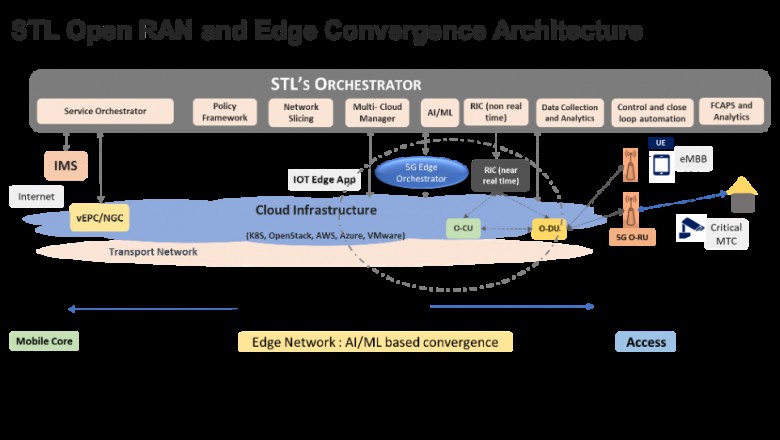views

Link textOverview
The Telco ecosystemhas been evolving through generations of wireless communication and now 5G isthere to connect almost everything with better capacity and near zero latency.While mobile operators have continued capacity growth with lower latency, cuttingcosts and seeking revenue from new service opportunities are the new thingsthey are focusing on. These will drive fundamental changes in the economies ofthe new network. Network infrastructure products with open interfaces arecrucial in this context, to reduce costs and create a new ecosystem for serviceinnovation. Mobile operators have been successful in cutting costs at the coreof the network by investing in new architectures that leverage Network FunctionVirtualization (NFV) and Software-Defined Networking (SDN), creating a morecompetitive open ecosystem for software and hardware. However, theinfrastructure of the radio access network which drives the largest share ofthe operator’s CAPEX remains locked into proprietary hardware and softwarethereby limiting flexibility and choice of deployment for operators. At STL,together with our partners, we offer an open and virtualized Radio AccessNetwork which helps service providers create an Open, Disaggregated andVirtualized 5GC solution aligned with 3GPP. We are in the process of certifyingspecific uses cases in the field by working with leading mobile operators aswell as private enterprises.
This paper explainshow STL solutions bring agility, flexibility, and cloud economics to 4G and 5Gnetworks in the Open RAN Telco ecosystem.
Open RAN Drivers
Open RAN (O-RAN) introduces intelligence through deep learning-based technologies like trained AI/ML models which are applied at both component and network levels which enables dynamic radio resource allocation and optimizes network efficiency in the RAN architecture. It automates the operation of the network functions reducing OPEX. Open interfaces eliminate purpose-build and proprietary hardware to facilitate the multi-vendor ecosystem which could lower CAPEX through increased vendor competition and network system improvements. This will make it easier for smaller operators with limited resources to adopt open RAN. Operators do not have to depend on a single vendor for rolling out new features, minimizing the danger of vendor lock-in, and helping in fast pace deployment of the network while providing supply chain security and flexibility bringing openness to the ecosystem. Openness also provides operators with an opportunity to customize the network to suit their own unique needs with the ability to select the best solutions for different parts of their radio networks. It encourages more vendors to enter the market and challenge the network problems with their diverse solutions. These new market players will future-proof the network’s evolution.
Open RANEcosystem
The Open RAN (O RAN) concept is about disaggregating the RAN functionality by dividing the user plane from the control plane into separate elements, using a fully programmable software-defined mobile network solution based on open interfaces that run on commercial off-the-shelf (COTS) hardware. Traditional mobile networks were built on closed, proprietary software and purpose-built hardware. But today using the Open RAN concepts it can be disaggregated. From a long term perspective, it is a good sign for Open RAN that operators are the driving force behind the open RAN initiative. There are two main industry initiatives driving Open RAN:
TIP and O-RANannounced in February 2020 that they would begin collaborating more closely toensure that they did not duplicate each other’s efforts. The new agreementallows the two groups to share information, reference specifications, andconduct joint testing and integration efforts. This will help to maximize theefforts of both groups towards the common objective of open RAN.
Open RAN Business View and MarketOutlook
Conventional RANarchitecture components are proprietary hardware appliances. Mobile networkoperators spend a major part of their capital expenditure and operatingexpenditure on RAN. Day to day increasing traffic and flattening revenue persubscriber has made the utmost necessity of network operators to look for amore efficient RAN architecture upgrade.
Future RANarchitecture demands the following technological principles:
STL Open RAN (O RAN) Solutions
Sterlite Technologies Limited provides the finest optimum key solutions to the Open RAN architecture to address the business challenges.
STL’sVNF solutions, vCU and vDU are software-defined network entities constructedthrough a network function virtualization process. They possess cloud-nativecapabilities with security isolation, virtual resource allocation, acceleratorresource encapsulation, etc. benefits. STL’s VNF solutions are compliant withORAN standardized interfaces and can run on any standard COTS servers.
Conclusion:
Foreseeing to 5G technology, Open RAN architecture leads towards a multi vendor environment with interoperability functionality. STL contributes to strengthen the Make in India 5G technology by assembling an ecosystem of partners in hardware manufacturing and cloud computing. STL has invested in building a one-of-a-kind end-to-end development of fully programmable, open and disaggregated 5G-NR and Private LTE solutions. STL solutions leverage the real time intelligence to enhance the network performance. With use of Edge Convergence Orchestration, they ensure the best quality of service with maximum throughput. Digital networks ecosystem includes next-gen wireless (5G) portfolio for all markets. STL partners with global telecom companies, cloud companies, citizen networks and large enterprises to deliver solutions for their fixed and wireless networks for the current and future needs.
© 2020-21 stl.tech All Rights Reserved.












